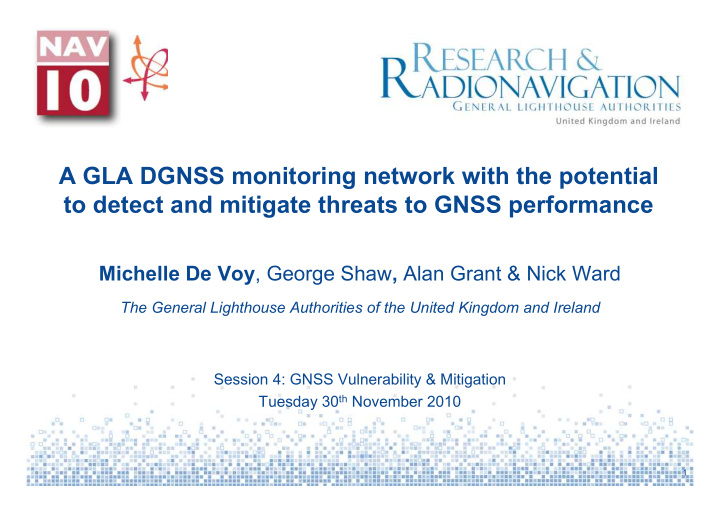



A GLA DGNSS monitoring network with the potential to detect and mitigate threats to GNSS performance Michelle De Voy , George Shaw , Alan Grant & Nick Ward The General Lighthouse Authorities of the United Kingdom and Ireland Session 4: GNSS Vulnerability & Mitigation Tuesday 30 th November 2010 1
Contents � Differential GPS � GLA monitoring � Reliance on GNSS � Potential threats to Users � Combined monitoring centre � Future mitigation � Conclusions 2
Differential GPS � Pre-defined frequencies in Europe: 283.5kHz to 315kHz � DGPS service uses: � Reference station � Comms link � DGPS receiver � DGPS corrections use Minimum Shift Keying modulation at 100 or 200 bits/second The components typically required for a marine radiobeacon DGPS (Grant 2002) 3
GLA DGPS Monitoring � GLAs operate 14 Differential radiobeacon GPS Stations � DGPS service enables users to improve their positional accuracy and have integrity in their position � DGPS stations are monitored to ensure that they are performing to the required standard. GLA marine DGPS stations, monitor and control stations and far-field monitor sites 4
GLA Independent Monitoring: Prototype � Proposed system will provide reliable, real-time data on GLAs’ DGPS performance in the far-field. � Development of permanent monitoring stations, will replace the current manual verification. � A continuous real-time DGPS monitoring system will provide performance data on each reference station: � beacon information (SNR, age of corrections and SS) ; � satellite constellation (number of visible satellites and DOP); � relative position accuracy (precision) (m); and � absolute position accuracy (m). 5
GLA Independent Monitoring Verification Stations Main Control & Monitor Site 6
GLA Independent Monitoring: Full System � A “thin” client option chosen to minimise costs and probability of failure at these sites � The location and number of verification sites has not yet been decided, however: � DGPS receivers should be sited within the station’s night-time coverage area to ensure good signal reception. Predicted coverage (taking into account SS, SNR and interference) from the 14 GLA DGPS stations during the day. 7
Reliance on GNSS � Worldwide GPS user applications include: � Transport, communications, security and power generation, make up the national backbone of critical infrastructure. � Dependant on: � Accuracy, integrity, availability and continuity of Position, Navigation and Timing (PNT) information. � GPS and GLONASS modernisation, and the introduction of Galileo will all enhance PNT availability 8
Potential Threats to Users � GPS provides users with information that is taken for granted � GPS is embedded in marine navigation systems and a range of AtoNs. � Vulnerabilities include: � Low power of the signal � Solar Activity; � Satellite vehicle failures; � Unintentional Radio interference; � Jamming; and � Spoofing; Solar X-ray image from GEOS-15 on 16 th Nov ‘10 9
Ionospheric Effects on GNSS � GNSS signals are delayed proportionally to the number of free ions (TEC) � GLAs’ DGPS corrections reduce the common mode errors, including ionospheric effects. � GNSS at risk during Solar TEC over various parts of the Earth, from the North pole aspect. Maximum and high solar activity 10
Ionospheric Effects on GNSS Predicted solar sunspot activity using observed data up to September 2010 11
GPS Satellite Numbers � GPS coverage ‘windows’ found (3 satellites in view) � Horizontal position errors increased by 50% � Occasional error spikes ~ tens of metres � GPS outages last up to 10 minutes � Dynamic simulation: up to 10km errors build up for fast vessels Three-satellite window over Belfast (October 2009, travelling >35 knots 21-satellite constellation) 12
Jamming GPS positions reported inland, 22km away from true position, during jamming trial 13
Combined monitoring centre � Each user type should monitor the GNSS constellations and the system performance to confirm availability. � A national GNSS monitoring centre , which advises on GNSS outages, space weather and also collates interference information for all GNSS users. � Network could advise users of faults or events. � Network could include detecting and locating jammers or tracking mobile GNSS devices. � The specific need for a national coordinated monitoring network is open for discussion Source: Maersk Line 14
Future mitigation Warn users of expected outages and mitigate the effect of � GPS loss where possible. � To ensure that GLA services meet the mariners need, the GLAs will monitor the development of new GNSS. � The GLAs could assess the feasibility of a common GNSS performance and monitoring network by 2015 with other stakeholders. � Possibly in the future : � A GLA network which monitors GPS/DGPS feeding into a central inter- agency monitoring network to improve detection of GPS outages and errors. � Unified network could be used to inform users of past, present and future GNSS problems. 15
Conclusions � GLA DGPS can enhance positional accuracy and integrity. � Prototype DGPS monitoring system has been designed. � Full DGPS monitoring system is being developed to monitor all 14 DGPS stations. � Wide reliance on GPS � GNSS threats reduce GPS availability and accuracy � Central network could provide warnings to users. GLA independent monitoring could feed into a national network, which monitors all GNSS threats - coordinated by a central national body. � Aims to promote discussion and collaboration with other organisations on GNSS monitoring. 16
THANK YOU Michelle.DeVoy@gla-rrnav.org 17
Recommend
More recommend